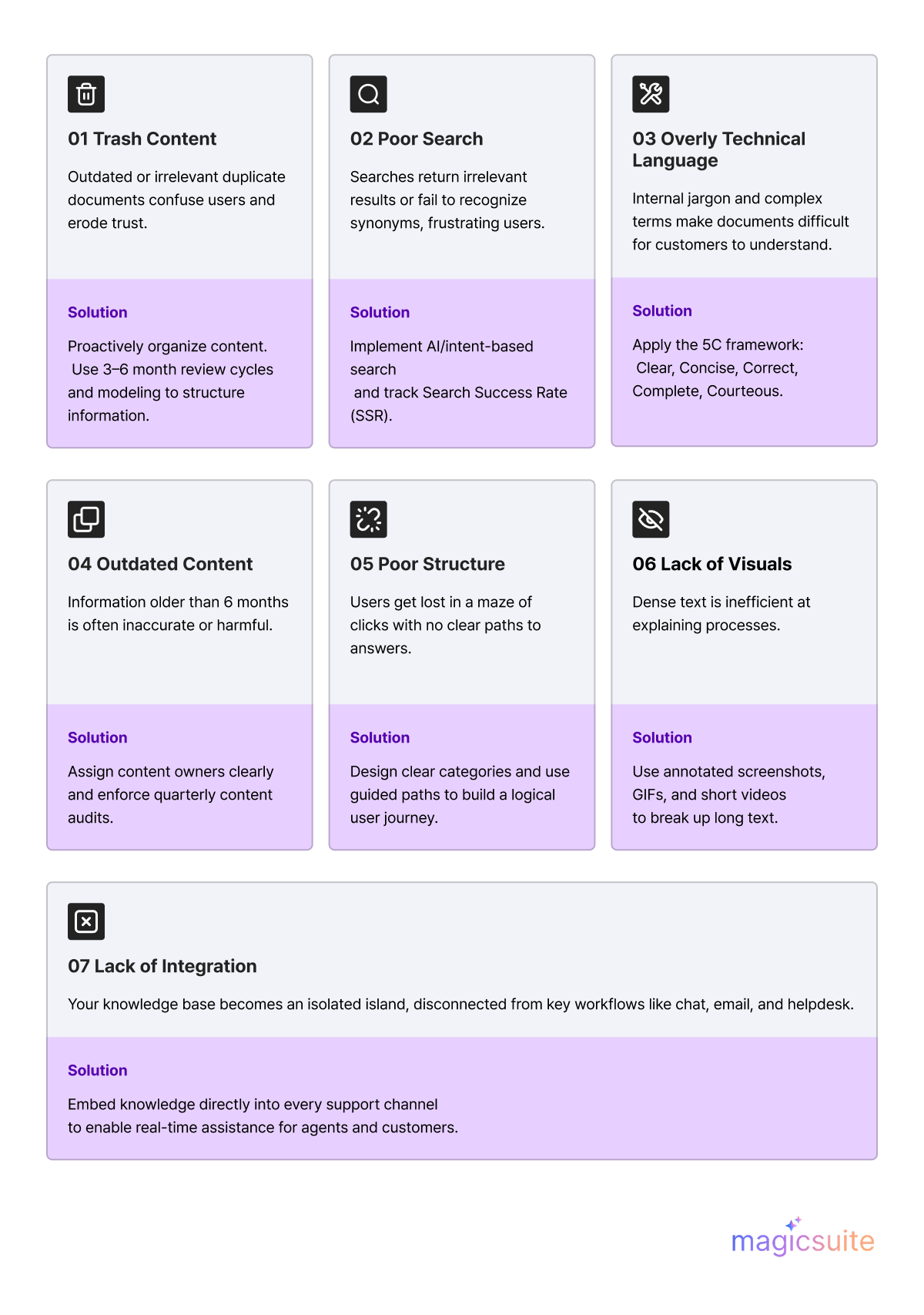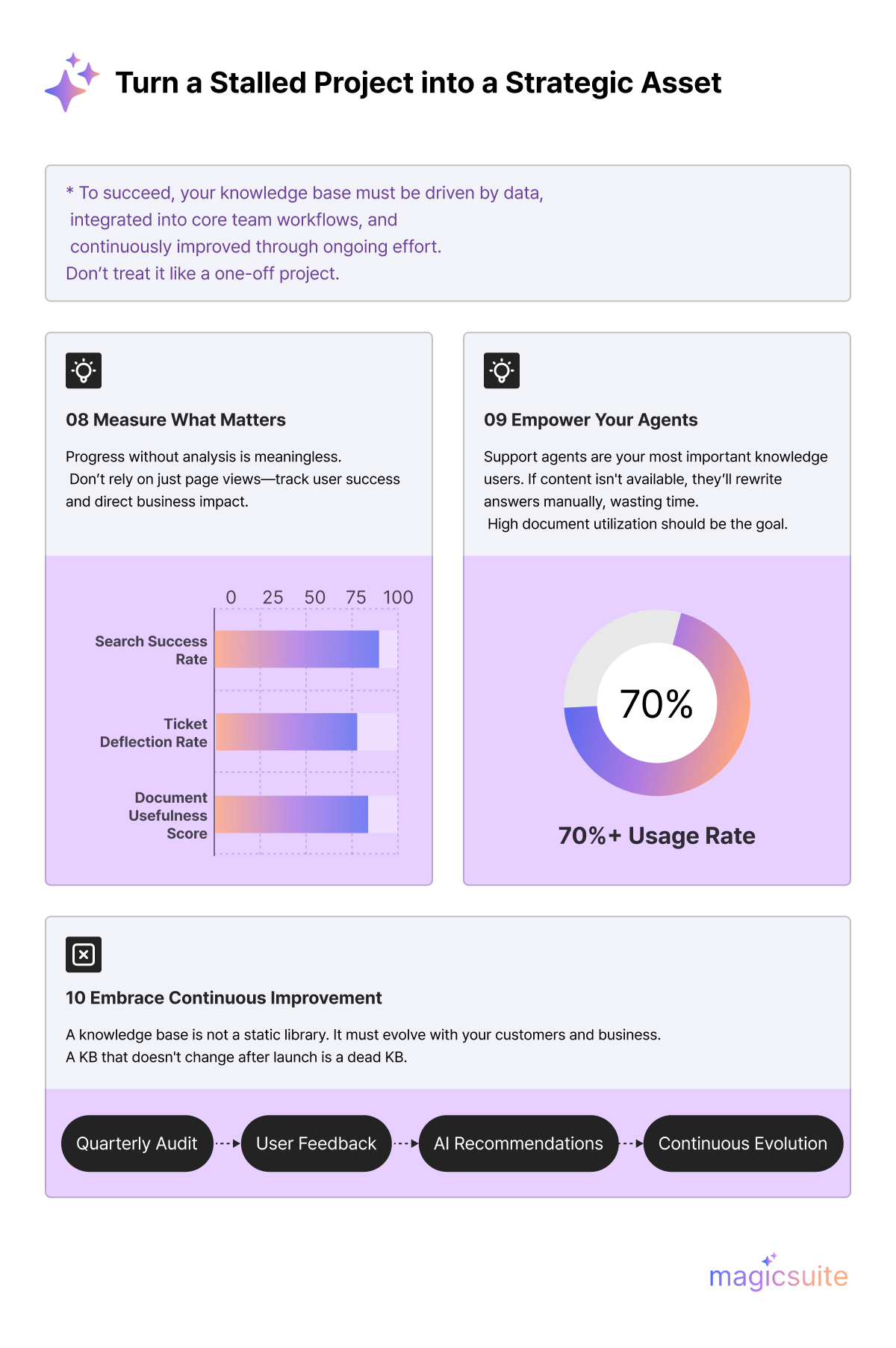Discover the 10 most common mistakes—from poor search to static content—and learn actionable fixes to deflect support tickets, improve customer experience (CX), and boost your bottom line.

Most company knowledge bases are a hot mess. They’re clunky to search, outdated, and filled with jargon nobody wants to read. Instead of solving problems, they create new ones. In fact, research from Forrester shows that poorly executed self-service can actually increase customer effort and drive churn. On the flip side, a well-structured knowledge base can deflect up to 40% of support tickets and save millions in costs.
So why do so many businesses get it wrong? Because they treat their knowledge base like a dusty FAQ graveyard instead of a living, breathing product.
In this article, we’ll break down the 10 most common knowledge base mistakes companies make and, more importantly, show you exactly how to fix them.

Customer expectations have leveled up. AI-powered chatbots, instant search, and personalized self-service are now the baseline. Gartner predicts that by 2025, 80% of customer service organizations will abandon traditional scripts in favor of AI-driven knowledge bases.
That means if your KB is still stuck in 2015 with broken links, outdated policies, and endless walls of text you’re not just behind. You’re actively bleeding trust, tickets, and revenue. The companies winning in 2025 are the ones treating their knowledge base like a product: constantly updated, user-tested, and integrated everywhere customers look for answers.

Most companies launch a “knowledge base” by dumping FAQs into a page and calling it a day. FAQs are reactive and shallow. They answer what’s already been asked, but they don’t scale, don’t cover edge cases, and definitely don’t meet customer expectations.
When your KB looks like an FAQ graveyard, two things happen:
The Fix:
Create your knowledge base like a product, not a filing cabinet. That means:
Companies that manage their knowledge base as a product (with roadmaps, KPIs, and updates) report 25–35% higher ticket deflection rates compared to those using an FAQ-style setup. If your KB hasn’t been updated since last quarter, it’s already outdated. Customers move faster than your FAQ list.
Most knowledge bases have a search bar that’s basically a glorified CTRL+F. Customers type “reset login” and the system spits out results about “authentication protocols” from 2016. Frustration skyrockets, tickets pile up, and your KB earns a reputation as useless.
The Fix:
Companies with advanced KB search see up to 35% higher first-contact resolution and drastically lower ticket volume. If your KB search can’t handle synonyms, you’re basically telling customers: “Speak our corporate jargon or figure it out yourself.” That’s not support. that’s customer sabotage.
Most KB articles read like legal contracts written by a lawyer trapped in a corporate boardroom. “Please be advised to commence resetting your authentication credentials…” Seriously? Nobody talks like that, and nobody wants to read it.
The Fix:
KB articles with visuals and simple language have 30–40% higher helpfulness ratings and drastically reduce follow-up tickets. If your article takes longer to decode than a CIA memo, congratulations. You’re actively frustrating your customers. They don’t want corporate poetry; they want solutions. Fast.
Products evolve. Policies change. Yet, KB articles sit there, untouched, like fossils. Outdated content doesn’t just annoy customers, it destroys trust. Imagine Googling “refund policy” only to find last year’s instructions that don’t apply anymore. That’s how you turn a loyal customer into a Twitter rant.
The Fix:
If your KB hasn’t been updated since your company’s rebranding in 2018, simply delete it. It’s not “legacy documentation.” It's a digital landfill.
Your Customer Service Knowledge Base isn’t a choose-your-own-adventure novel. If customers need five clicks and a prayer to find “Reset Password,” you’ve already lost. Poor structure creates friction, and friction = tickets.
The Fix:
If your KB feels like navigating IKEA without a map, congratulations: you’ve built a digital nightmare maze. Customers shouldn’t need a sherpa to find basic answers.
Humans process visuals 60,000x faster than text. Yet, most KBs resemble a PhD dissertation with no screenshots. Expecting customers to fix problems with pure text is like handing them IKEA furniture without the pictures.
The Fix:
If your KB is just endless text, you’re not helping customers. A picture saves a support ticket. Use them.
Most companies stop at publishing KB articles and pray customers will “find it.” Spoiler: they won’t. Customers live in chat, email, and apps. If your KB isn’t there, it’s invisible.
The Fix:
Teams that integrate KB with live chat see 20–40% lower ticket volume. If your KB exists on some lonely subdomain no one visits, it’s not a knowledge base, it’s a glorified storage closet.

If you’re not measuring KB performance, you’re throwing spaghetti at the wall and hoping it sticks. Metrics like search success rate, deflection rate, and article helpfulness exist for a reason.
The Fix:
Unhinged Take:
If you don’t measure your KB, you’re not managing it. You're babysitting it.
Your support agents are your KB’s first customers. If they’re rewriting answers instead of linking articles, your KB is officially a ghost town.
The Fix:
If your own agents don’t use the KB, why should customers? That’s like a chef refusing to eat their own cooking. Huge red flag.
Too many companies launch a KB, pat themselves on the back, and never touch it again. Bad move. Customer needs evolve daily; your KB should too.
The Fix:
A static KB is like a gym membership you bought but never used. Looks good on paper, delivers zero results. Either evolve it or kill it.
Check out How to Create a Knowledge Base for Customer Service
Avoiding these 10 mistakes won’t just make your KB better — it’ll make your customer support scalable, your agents happier, and your business cheaper to run.
Want a knowledge base that automatically stays updated and integrates everywhere? MagicTalk, an AI-powered knowledge base, grows with your business. Learn more here.

Luke is a technical market researcher with a deep passion for analyzing emerging technologies and their market impact. With a keen eye for data and trends, Luke provides valuable insights that help shape strategic decisions and product innovations. His expertise lies in evaluating industry developments and uncovering key opportunities in the ever-evolving tech landscape.